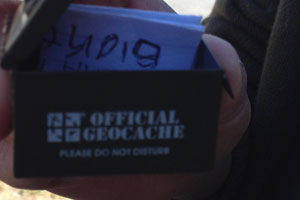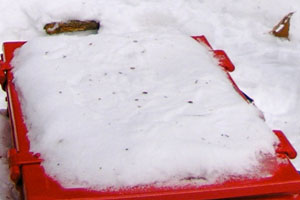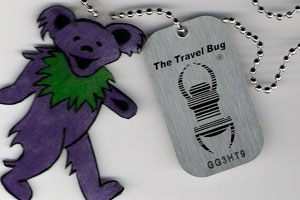Geocaching Guide

Treasure hunting takes many shapes and forms. There's the classic pirate treasure map popularized in movies and literature, the scavenger hunt, the metal detector, and more. While it's exciting to find hidden treasures unexpectedly, it's even more fun to follow directions and clues knowing that you'll eventually find that treasure. Enter geocaching, the worldwide treasure hunt that anyone with a GPS device can take part in!
The First Geocache
What is geocaching? Basically, geocaching is an outdoor recreational activity centered around using a GPS device to search for geocaches, which other geocachers hide and record the location of for others to find.
GPS, the Global Positioning System, was created back in the 1970s by the U.S. Department of Defense. It operates through satellites, which circle Earth and send navigational data to a GPS device. However, pre-2000, the Selective Availability feature was active, which limited the accessibility and accuracy of GPS for the public. At midnight on May 2, 2000, this feature was discontinued, and soon all GPS receivers were much more effective.
To test this upgrade and accuracy increase, Dave Ulmer, a computer consultant, hid a navigational target in the woods near Beavercreek, Oregon, on May 3. The container Ulmer used was a black bucket, and he included a logbook, pencil, and "treasures," such as videos, books, a slingshot, and software. Ulmer referred to this new idea as the "Great American GPS Stash Hunt," and he shared the coordinates of his hidden bucket on a GPS online community website.
Fellow GPS enthusiasts quickly found Ulmer's stash and took a liking to this new outdoor activity. More people began to hide their own stashes and post the coordinates online. Mike Teague, the first person to find Ulmer's stash, compiled other posted stashes on his own website, and he created a "GPS Stash Hunt" mailing list.
The Evolution of Geocaching
The word "geocaching" was suggested by Matt Stum, a "GPS Stash Hunt" subscriber. The combination of the words "geo" and "cache" makes sense for an activity based around geography, Earth, a stash, and technology.
The main resource for geocaching, www.geocaching.com, was established by Jeremy Irish, a Seattle web developer. Irish was intrigued by the melding of treasure hunting and high-tech gadgets, and his instant love for the activity inspired him to set up www.geocaching.com. He included a database for geocache listings, and with Mike Teague's help, opened the site to the geocaching community on September 2, 2000.
 From then on, geocaching rose in popularity and spread through word of mouth, media outlets (such as CNN), magazines (such as Slashdot), and by people who accidentally stumbled upon a geocache.
From then on, geocaching rose in popularity and spread through word of mouth, media outlets (such as CNN), magazines (such as Slashdot), and by people who accidentally stumbled upon a geocache.
Jeremy Irish partnered with Elias Alvord and Bryan Roth in late 2000 to form the company Groundspeak Inc., which would operate www.geocaching.com. Now, the website is the official resource for everything related to geocaching.
On www.geocaching.com, you can create your own account, search for active geocaches, receive clues and coordinates, and then go off on your geocaching trip. Today, geocaching isn't just for GPS enthusiasts or modern day treasure hunters. Instead, it has become a popular activity for friends, families, and everyone else year round.
Things to Know Before You Go
First and foremost, set up your personal geocaching account on www.geocaching.com. Once you have an account, you can easily search for other geocaches by region, or you can input a geocache that you've hidden. Every geocache listing has difficulty and terrain ratings, coordinates, geocache size, general description, and additional hints:
Planning
 Be aware of the difficulty and terrain before you go so you can plan accordingly. Geocaches are located on mountains, islands, fences, and many more spots.
Be aware of the difficulty and terrain before you go so you can plan accordingly. Geocaches are located on mountains, islands, fences, and many more spots.- Input the coordinates into your GPS device. You can even use your phone and the Geocaching App if your phone has GPS technology.
- Geocaches come in many sizes. Some are micro-sized (as small as a dime), some are large, and many regular-sized geocaches are ammo boxes or tupperware containers.
- The description provided by the geocache's owner usually includes directions and details about the surrounding area. If the geocache is particularly difficult, you can receive additional hints by decrypting a coded message with the description.
- Before you go on your treasure hunt, there are a few things you should keep in mind:
a. Many geocaches contain items or trinkets, such as coins, a pencil, or even a small toy. If you bring your own object, then you can swap one out for one of your own.
b. Additionally, there are sometimes travel bugs in a geocache. These are items with an official trackable tag that you can take to another geocache, leave it there, and then record its current location online so its owner knows.
The Hunt
- Once you've chosen a geocache and followed the directions to the location, your GPS device will point you in the right direction.
- If you pay attention to the geocache's description and the GPS device, and if you do a little exploring in the specified area, you should be able to find the geocache! (Note: If you can't find it, then you can list it as a Did-Not-Find and see online if other people had trouble. There's always a chance it might be missing.)
- Once you find the geocache, you usually have the option to sign the logbook with your username/date, swap out an item with one of your own, and take a travel bug to bring to another geocache.
- After you're done, make sure you try to re-hide it the same way you found it. If it was stuffed between rocks, put it back in where it was so others can find it.
- Congratulations, you've completed a geocache! Now you can add it to your online log and begin your hunt for the next one. Although there's much more to learn about geocaching, these are the basics for first-timers.
Fun Fact: Non-geocachers are referred to as Muggles (non-magical persons in the Harry Potter series). Although you can explain what you are doing if someone asks, it's fun to geocache discreetly.
Geocaches To Get You Started
There is an easy geocache in the parking area before the Shelving Rock Falls Trailhead. It's described as a mini bison tube with camo tape. Since this geocache is a microcache, it's small enough to be attached to something.
Coordinates: N 43.33.336 W 073.35.910
Just off Route 86 between Lake Placid and Saranac Lake is an easy geocache. The regular-sized geocache is a plastic tupperware container, and it's hidden near a spot where you can pull off the road and look around.
Coordinates: N 44.17.544 W 074.03.042
A small geocache is located on the right side of the museum in Speculator. The geocache is a round plastic box. You'll have to walk to the building, and don't forget to bring a writing utensil!
Coordinates: N 43.30.000 W 074.21.994